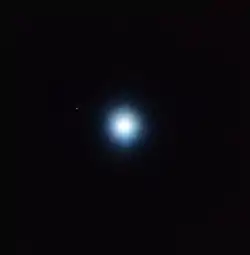CVSO 30
CVSO 30 (PTFO 8-8695) is a binary T Tauri star, located in constellation Orion at 1200 light years from Earth away with two candidate planets (CVSO 30 b and CVSO 30 c). Both candidate planets are gas giants. It is the first star around which potential planets have been found both by the transit method and by direct imaging.
| Observation data Epoch J2000.0 Equinox J2000.0 | |
|---|---|
| Constellation | Orion |
| Right ascension | 05h 25m 07.556s[1] |
| Declination | +01° 34′ 24.349″[1] |
| Apparent magnitude (V) | +16.26[2] |
| Characteristics | |
| Spectral type | M3[2] |
| Variable type | T Tau[2] |
| Astrometry | |
| Proper motion (μ) | RA: +1.73[1] mas/yr Dec.: +0.13[1] mas/yr |
| Parallax (π) | 2.861 ± 0.075[1] mas |
| Distance | 1140 ± 30 ly ly (349.5 ± 9.2[1] pc) |
| Details | |
| Mass | 0.39 ± 0.05[2] M☉ |
| Radius | 1.39[2] R☉ |
| Temperature | 3740[2] K |
| Age | 2.65[3] Myr |
| Other designations | |
2MASS J05250755+0134243, PTFO 8-8695 | |
| Database references | |
| SIMBAD | data |
Planetary system
| Companion (in order from star) |
Mass | Semimajor axis (AU) |
Orbital period (years) |
Eccentricity | Inclination | Radius |
|---|---|---|---|---|---|---|
| c (Unconfirmed) | 4.7 MJ | 660 | 27000 | — | — | — |
CVSO 30 may have two planets called CVSO 30 b and CVSO 30 c. CVSO 30 b is calculated to have a period of 10.76 hours (0.008 AU) and CVSO 30 c a period of 27,000 years (660 AU). Would it exist, CVSO 30 b would be a hot Jupiter planet orbiting the T Tauri star, with 6.2 Jupiter masses.[4]
Direct imaging of suspected CVSO 30 c, with calculated mass equal to 4.7 Jupiter's, has been achieved through photometric and spectroscopic high contrast observations carried out with the Very Large Telescope located in Chile, the Keck Observatory in Hawaii and the Calar Alto Observatory in Spain.[5] However, the colors of the object suggest that it may actually be a background star, such as a K-type giant or a M-type subdwarf.[6]
By 2020, phase of "dips" caused by suspected planet CVSO 30 b, have drifted nearly 180 degrees from expected value, thus ruling out the existence of planet. Instead, a rare type of stellar starspot activity with very large starspots is now suspected. Also, CVSO 30 is suspected to be a stellar binary, with the previously reported planetary orbital period equal to the rotation period of companion star.[7]
References
- "CVSO 30". SIMBAD. Centre de données astronomiques de Strasbourg. Retrieved 5 October 2018.
- Van Eyken, Julian C.; Ciardi, David R.; von Braun, Kaspar; Kane, Stephen R.; Plavchan, Peter; Bender, Chad F.; Brown, Timothy M.; Crepp, Justin R.; Fulton, Benjamin J.; Howard, Andrew W.; Howell, Steve B.; Mahadevan, Suvrath; Marcy, Geoffrey W.; Shporer, Avi; Szkody, Paula; Akeson, Rachel L.; Beichman, Charles A.; Boden, Andrew F.; Gelino, Dawn M.; Hoard, D. W.; Ramírez, Solange V.; Rebull, Luisa M.; Stauffer, John R.; Bloom, Joshua S.; Cenko, S. Bradley; Kasliwal, Mansi M.; Kulkarni, Shrinivas R.; Law, Nicholas M.; Nugent, Peter E.; et al. (2012). "The Ptf Orion Project: A Possible Planet Transiting a T-Tauri Star". The Astrophysical Journal. 755 (1): 42. arXiv:1206.1510. Bibcode:2012ApJ...755...42V. doi:10.1088/0004-637X/755/1/42. S2CID 2753064.
- "Extrasolar Planets Encyclopaedia". Retrieved 15 November 2016.
- Schmidt, T. O. B.; Neuhäuser, R.; Briceno, C.; Vogt, N.; Raetz, St.; Seifahrt, A.; Ginski, C.; Mugrauer, M.; Buder, S.; Adam, C.; Hauschildt, P.; Witte, S.; Helling, Ch.; Schmitt, J. H. M. M. (2016). "Direct Imaging discovery of a second planet around the transiting planet host star CVSO 30". Astronomy & Astrophysics. 593: A75. arXiv:1605.05315. Bibcode:2016A&A...593A..75S. doi:10.1051/0004-6361/201526326. S2CID 54580621.
- "Amazing Photo Shows Likely Alien Planet 1,200 Light-Years Away". MSN. 21 June 2016. Archived from the original on 11 August 2016. Retrieved 22 June 2016.
- Lee, Chien-Hsiu; Chiang, Po-Shih (2018). "Evidence that the Planetary Candidate CVSO30c is a Background Star from Optical, Seeing-limited Data". The Astrophysical Journal. 852 (2): L24. arXiv:1712.08727. Bibcode:2018ApJ...852L..24L. doi:10.3847/2041-8213/aaa40b. S2CID 119270170.
- PTFO 8-8695: Two Stars, Two Signals, No Planet, 2020, arXiv:2005.10253
Further reading
Koen, C. (2015). "Multicolour time series photometry of the T Tauri star CVSO 30". Monthly Notices of the Royal Astronomical Society. 450 (4): 3991–3998. Bibcode:2015MNRAS.450.3991K. doi:10.1093/mnras/stv906.
Raetz, St.; Schmidt, T.O.B.; Czesla, S.; Klocová, T.; Holmes, L.; Errmann, R.; Kitze, M.; Fernández, M.; Sota, A.; Briceño, C.; Hernández, J.; Downes, J. J.; Dimitrov, D.P.; Kjurkchieva, D.; Radeva, V.; Wu, Z.-Y.; Zhou, X.; Takahashi, H.; Henych, T.; Seeliger, M.; Mugrauer, M.; Adam, Ch.; Marka, C.; Schmidt, J.G.; Hohle, M.M.; Ginski, Ch.; Pribulla, T.; Trepl, L.; Moualla, M.; et al. (2016). "YETI observations of the young transiting planet candidate CVSO 30 b". Monthly Notices of the Royal Astronomical Society. 460 (3): stw1159. arXiv:1605.05091. Bibcode:2016MNRAS.460.2834R. doi:10.1093/mnras/stw1159. S2CID 56346914.
